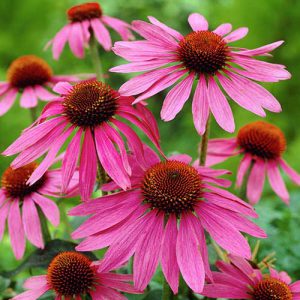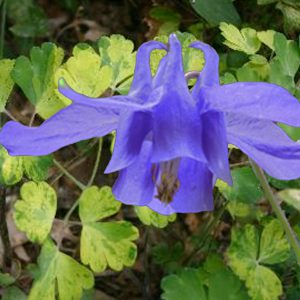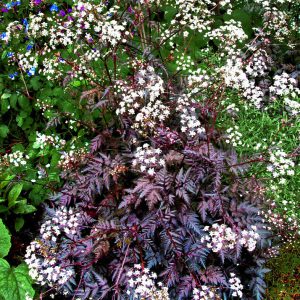- 1-9 pkts $4.50
- 10 pkts FREE
- Express post $12
Eriogonum fasciculatum
CALIFORNIA BUCKWHEAT
Eriogonum fasciculatum is a pretty shrub, and perfectly adapted for gardens in hot, dry and arid areas.
Not permitted for entry to WA
Buckwheat for making pancakes
And it is also a source for tasty Buckwheat seeds for making pancakes, flour, muesli, porridge and breads.
And even creating beer, whisky and tea.
Buckwheat is a super healthy, gluten-free food.
Pretty shrub for arid, hot, dry gardens
Eriogonum fasciculatum makes such a pretty shrub – so it would always be worth growing, even if you never harvested one seed.
Because it makes a low, wide shrub covered with flower heads from mid-spring right through summer.
Covered with mass of white-pink flower heads
Buckwheat shrubs are prolific bloomers (and hence produce abundant Buckwheat seeds for harvesting).
They cover themselves with a mass of dense flower heads, which open white in mid-spring, and mature to pink and rose shades through the many weeks of summer blooming.
Before finally turning russet red in autumn as the seeds ripen for harvest.
branches can also be harvested at any stage as vase flowers.
Long blooming through spring & summer into autumn
So Buckwheat shrubs give great flower-power and value for a very long blooming period.
Attractive low wide shrub with fine grey wooly foliage
The whole of Eriogonum fasciculatum is an attractive outfit, as the evergreen shrub is covered with fine, grey-green linear foliage which makes the perfect foil for the white-pink flower heads.
Each shrub also makes an architectural shape with its many branches and stems, tipped with the round flower heads.
Perfect for arid gardening with little water
Shrubs of Eriogonum fasciculatum are natural desert dwellers, and can withstand long periods heat and drought once established, as well as severe winter frost.
As the name suggests, it is a shrub from the deserts of California and Mexico.
Loves sandy, rocky, & well drained soils
The only thing that seems to be able to quickly kill a Buckwheat shrub is too much water.
They are generally untouched by any pests and diseases
Rabbits & deer wont touch them
Not even rabbits and deer want to eat Eriogonum fasciculatum.
Boon for birds, bees and pollinators in the garden
Though native Finches and other seed eating birds will strip the autumn Buckwheat seeds with relish, unless you net the bushes.
While the native Honeyeater birds love sipping from the nectar rich flower heads, especially as the diner is open for so many weeks over the hottest parts of the year.
Traditional medicinal plant
Native American First Nation Indians traditionally used the roots and leaves to treat headaches and nausea; the seeds for grinding as flour (as we do); and even the hard stems for piercing their ears and sowing.
Low maintenance, evergreen shrub
Eriogonum fasciculatum makes a low, wide, architectural shrub which rarely needs any pruning.
You can trim it over lightly with the hedge trimmer every few years if you wish to shape or change the height, but regular pruning is not necessary.
Evergreen shrub approx. 80-90 cm. High x 90-1.2 m Wide
Regular watering is not necessary
Edible crop plant
The seed heads are harvested in late autumn and used as grain for making pancakes, flour, muesli, porridge and breads, and even creating beer, whisky and tea.
Buckwheat is a super healthy, gluten-free food.
SEED SOWING ADVICE: Quick & Easy
Sow seeds of Eriogonum fasciculatum at any time of year indoors when suitable temperatures are available.
Or scatter directly in the garden in late autumn/ early winter.
Sow indoors for optimum germination: First sow the seeds in a punnet on the surface of good quality seed raising mix.
If the chosen seed raising mix is not a sandy mix – Then it is a good idea to mix a little extra sand into the seed raising mix to suit these desert plants best.
Now gently pat the seeds to the surface of the raising mix to ensure good contact.
But only barely sprinkle the seeds with sieved mix or sand, as these seeds need light to germinate.
Moisten the punnet
Then stand the sown punnet in a shallow water bath and allow the moisture to percolate up to the surface of the mix from below.
Now give an optional pretend winter if you wish
The seeds of Eriogonum fasciculatum are not hard to germinate – some seeds will germinate without a period of chilling.
But the rate of germination will be greatly improved by giving a period of chilling – so your choice, depending on how many plants you want.
To give a pretend winter
Now wrap the moist sown punnet in cling-wrap, or in a clip lock bag, and place in the fridge (not the freezer) for 6 weeks.
While this step is not essential – it does greatly enhance the germination rate of Buckwheat.
Mark the punnet with the date when you should bring it out.
Then bring out to a warm, well lit place for sprouting
After the period of chilling – moisten the punnet again, and place the punnet in a warm, well-lit position (not in any direct sunlight).
Temperatures of 18-25°C are best for rapid and optimum germination.
It is a good idea to use a heat mat to maintain consistent warmth for maximum germination.
Keep moist but not wet – these desert plants do not like to be too wet.
Seedlings may begin to emerge in just a few days.
* Please note it is normal for seeds of Eriogonum fasciculatum to stagger their germination. Some will come more quickly, while others will be slower. This is a natural defensive mechanism of a desert plant.
So be patient – do not discard the punnet too quickly.
Prick out the seedlings quickly and pot on or plant out, as the little plants rapidly make long roots.
Seed Count: 50 seeds per pack.
We always aim to exceed the stated seed count and give a generous serve.
Click here for our Nursery Open Days & Open Gardens Information
https://www.gardivalia.com.au/open-gardens
Click here to go back to Seeds Shop
https://www.seedscape.net.au/shop/
Related products
-
Add to WishlistAlready In WishlistAdd to Wishlist
-
Add to WishlistAlready In WishlistAdd to Wishlist
-
Add to WishlistAlready In WishlistAdd to Wishlist
-
Add to WishlistAlready In WishlistAdd to Wishlist





